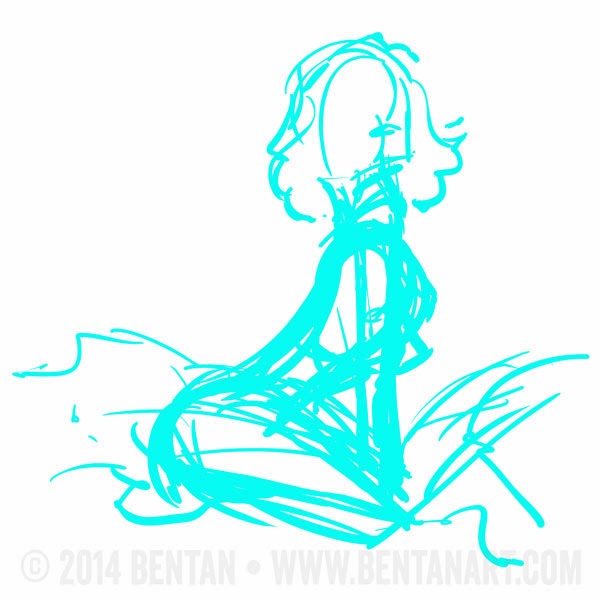This is the finished piece.
A walkthrough...
I start in Corel Painter. I have a reference photo that I'm only very loosely using. The first challenge is just getting the basic shapes and proportions. At this point I'm mostly trying to figure out the curve of the back, the hips, and the shoulders. The head is barely attached right -- it's something I always have trouble with. The reference photo actually has a really straight back, but I decided to curve it. I'm drawing using the Scratchboard tool. The canvas is already 3000px x 3000px and I'm drawing on a new layer. The pen is fairly thick at this point, maybe 60px. This duplicates the feeling of drawing thumbnails -- the thick pen forces you to work on large shapes and not on details.

I create a new layer, and change the color of the pen. Now working in the details. I decide I want a shirt on. Spend a little more time trying to get head and face in right. At this point I decide that I want her to yawn, so I also add her raised arm to help sell that. Notice how far everything has shifted from the blue.
Create another layer and hide the blue. Still using the scratchboard tool, but now with black ink and a much smaller tip. Maybe around 18px. The key here is to draw very fast and loose -- if you draw slow, it shows and sucks all the life out.. If a line doesn't look right, undo and do it over again. It can take me 10 tries to get a line right. Notice there's a lot more shifting going on. I'm relying on the red lines to give me the basic overall shape, but I'm shifting bits and pieces around quite a bit. I also have to do a fair amount of refinement of some lines, erasing edges and filling in others.
Also, this started with just the body and the head. I put the hair on another layer, and the back arm on another layer. This way if I screw those up, I can easily erase them without erasing my original lines. Later I merge the three layers into one.
New layer with the sheets. Again so they can be erased, but also because I know I want the lines to be a different color. I lightened the main lines just to emphasize the sheets here. I didn't actually do that while I was drawing.
Lately I like to start coloring with the background. It gives me some idea how to handle the skin. This is still in Painter, on a new layer. My standard coloring tool is the Tinting Basic Round. I like how it lays down color and lets me do gradations. Feels a bit like watercolors.
Skin coloring. Same tools. I erase a bit of the color for the highlights.
Shirt on a new layer.
Hair on a new layer.
Now I'm starting to evaluate the weighting of the overall piece and where your eye is drawn to. I want it to be drawn more to the face so I try darkening her hair some.
Now coloring the lines. To do this I move to Photoshop. I create a new Hue and Saturation Adjustment layer and clip it to the ink lines. Then adjust it until I get the color I like.
Add another adjustment layer with Hue and Saturation, this time for the hair -- it's slightly redder, though not so obvious now. I then create a mask on the adjustment layer so that it's only modifying the hair lines.
Do the same thing for the shirt. This time it's more obvious. So now I have three Adjustment layers stacked on top of the lines. I go back and forth tweaking the three until they kind of sit well together. The blue's a little too strong in retrospect...
Adjusting again to shift the focus. I lighten up the window area with a new layer painting white on it.
Another subtle shift here. The brown body lines leave the mouth too light, so I add another layer and paint in a darker open mouth.
And a final texture touch. I grab a texture of paper, put it on top, and set it to multiply. Then scale back the opacity until I get a hint of texture on the page. Et voila! The final piece!